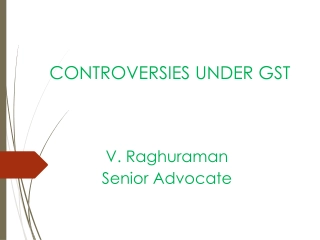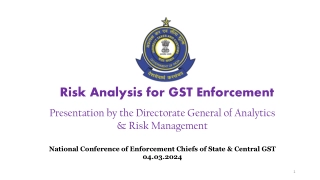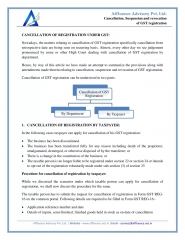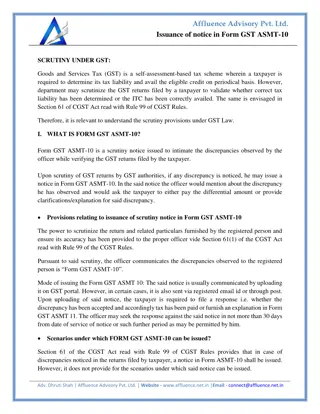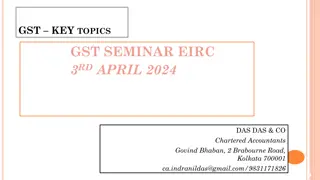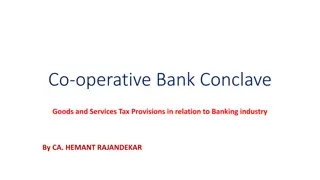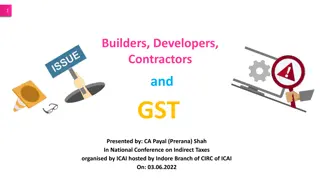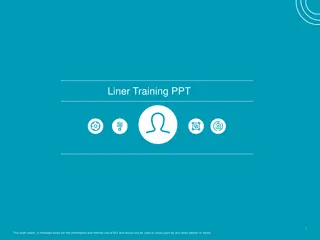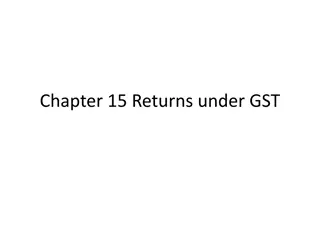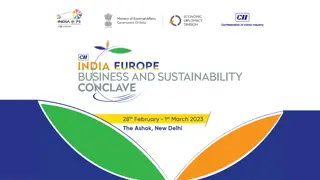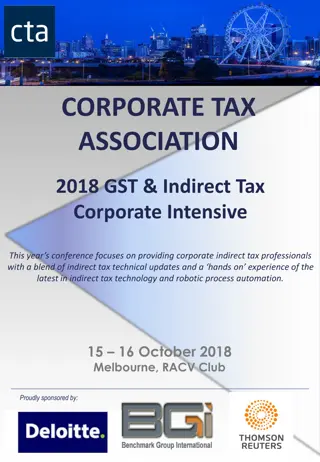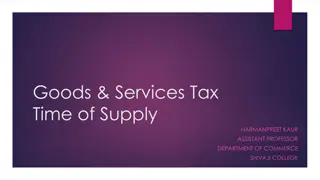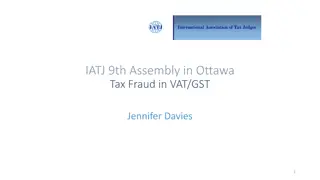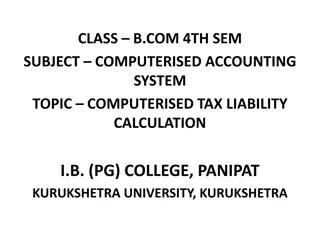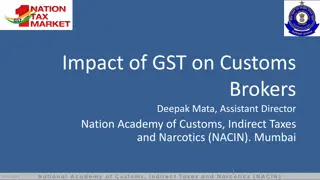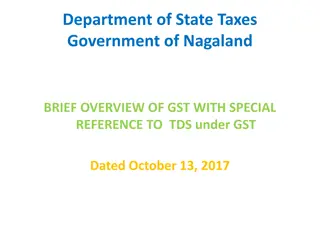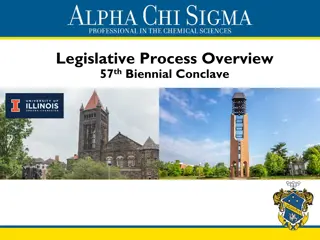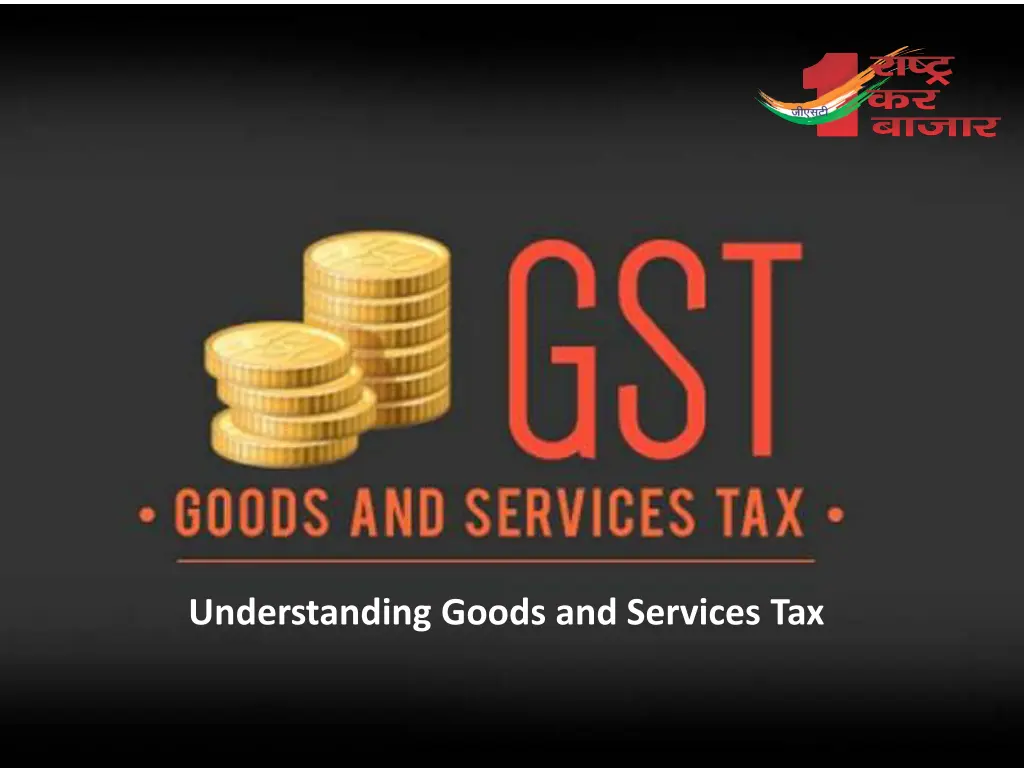
Understanding Goods and Services Tax: Features, Benefits, and Structure
Explore the comprehensive details of Goods and Services Tax (GST) including its design, main features, historical development, existing indirect tax structure in India, and the constitution of the GST Council. Learn about the efforts put in, the constitutional amendments made, and the structure of the GST Council for efficient administration of GST in India.
Uploaded on | 0 Views
Download Presentation

Please find below an Image/Link to download the presentation.
The content on the website is provided AS IS for your information and personal use only. It may not be sold, licensed, or shared on other websites without obtaining consent from the author. If you encounter any issues during the download, it is possible that the publisher has removed the file from their server.
You are allowed to download the files provided on this website for personal or commercial use, subject to the condition that they are used lawfully. All files are the property of their respective owners.
The content on the website is provided AS IS for your information and personal use only. It may not be sold, licensed, or shared on other websites without obtaining consent from the author.
E N D
Presentation Transcript
Agenda Design of GST Main features of GST Law Administration and IT Network Benefits of GST and Way Forward 1
The Effort and Work Done 18000 + Man Hours of discussion by GST Council 30 + Sub-Groups & Committees 10 Years In Making 14 EC Meetings in 10 years and 13 GSTC Meetings in 6 months Constitution Amendment and 5 Laws approved by collaborative effort 175 + Officers Meetings 2
Existing Indirect Tax Structure in India State Taxes Central Taxes Central Excise duty Additional duties of excise Excise duty levied under Medicinal & Toilet Preparation Act Additional duties of customs (CVD & SAD) Service Tax Surcharges & Cesses State VAT / Sales Tax Central Sales Tax Purchase Tax Entertainment Tax (other than those levied by local bodies) Luxury Tax Entry Tax (All forms) Taxes on lottery, betting & gambling Surcharges & Cesses GST Constitution amended to provide concurrent powers to both Centre & States to levy GST (Centre to tax sale of goods and States to tax provision of services) 3
Understanding CGST, SGST, UTGST & IGST State 1 Foreign Territory State 2 Union territory without legislature 4
Features of Constitution Amendment Act Alcohol for human consumption Power to tax remains with the State Five petroleum products crude oil , diesel, petrol, natural gas and ATF GST Council to decide the date from which GST will be applicable Part of GST but power to levy additional excise duty with Central Government Tobacco Entertainment tax levied by local bodies Power to tax remains with the State 5
GST Council - Constitution Chairperson Union FM Vice Chairperson - to be chosen amongst the Ministers of State Government Members - MOS (Finance) and all Ministers of Finance / Taxation of each State Quorum is 50% of total members States - 2/3 weightage and Centre - 1/3 weightage Decision by 75% majority Council to make recommendations on everything related to GST including laws, rules and rates etc. 6
GST Council - Decisions (1/2) Threshold limit for exemption to be Rs. 20 lac (Rs. 10 lac for special category States) Compounding threshold limit to be Rs. 50 lac with - Categories Tax Rate Traders 1% Manufacturers 2% Restaurants 5% Government may convert existing Area based exemption schemes into reimbursement based scheme Four tax rates namely 5%, 12%, 18% and 28% Some goods and services would be exempt Separate tax rate for precious metals 7
GST Council - Decisions (2/2) Cess over the peak rate of 28% on specified luxury and sin goods To ensure single interface all administrative control over 90% of taxpayers having turnover below Rs. 1.5 cr would vest with State tax administration 10% of taxpayers having turnover below of Rs. 1.5 cr. would vest with Central tax administration taxpayers having turnover above Rs. 1.5 cr. would be divided equally between Central and State tax administration 8
Compensation Mechanism for States Revenue of all taxes subsumed in GST by the State for 2015-16 as the base Assumption of 14% Annual Growth Rate Compensation to be provided through Cess Cess only on few specified luxury and demerit goods 9
Main Features of the GST Act (1/4) All transactions and processes only through electronic mode Non-intrusive administration PAN Based Registration Registration only if turnover more than Rs. 20 lac Option of Voluntary Registration Deemed Registration in three working days Input Tax Credit available on taxes paid on all procurements (except few specified items) 10
Main Features of the GST Act (2/4) Credit available to recipient only if invoice is matched Helps fight huge evasion of taxes Set of auto-populated Monthly returns and Annual Return Composition taxpayers to file Quarterly returns Automatic generation of returns GST Practitioners for assisting filing of returns GSTN and GST Suvidha Providers (GSPs) to provide technology based assistance 11
Main Features of the GST Act (3/4) Tax can be deposited by internet banking, NEFT / RTGS, Debit/ credit card and over the counter Concept of TDS for certain specified categories Concept of TCS for E-Commerce Companies Refund to be granted within 60 days Provisional release of 90% refund to exporters within 7 days 12
Main Features of the GST Act (4/4) Interest payable if refund not sanctioned in time Refund to be directly credited to bank accounts Comprehensive transitional provisions for smooth transition of existing tax payers to GST regime Special procedures for job work System of GST Compliance Rating Anti-Profiteering provision 13
GST Network (GSTN) A section 25 private limited company with Strategic Control with the Government To function as a Common Pass-through portal for taxpayers- submit registration application file returns make tax payments To develop back end modules for 25 States (MODEL II) Infosys appointed as Managed Service Provider (MSP) 34 GST Suvidha Providers (GSPs) appointed 14
Return Process (Example : Return for July 2017) Recipient Amend or modify and file GSTR 15 Recipient Amend or modify and file GSTR- -2 by 15th th of August Supplier and Recipient To reconcile details by 17th th of August Supplier and Recipient To reconcile details by 17 Taxpayer Taxpayer 2 by of August of August GSTN GSTN Supplier Supplier Auto invoice details in GSTR Auto- -Population invoice details in GSTR- -2 of recipient Population of of File GSTR- -3 by 20 of August & pay tax File GSTR of August & pay tax 3 by 20th th 2 of recipient Supplier Supplier Supplier Supplier Invoice Details upload from 1 of August Invoice Details upload from 1st st of July to 10 of August File GSTR- -I by 10 of August File GSTR of August I by 10th th of July to 10th th 16 15
Role of CBEC (Now CBIC) Role in Policy making: Drafting of GST Law, Rules & Procedures CGST, UTGST & IGST Law Assessment, Audit, Anti-evasion & enforcement under CGST, UTGST & IGST Law Levy & collection of Central Excise duty on products outside GST Petroleum Products & Tobacco Levy & collection of Customs duties Developing linkages of CBEC - GST System with GSTN Training of officials of both Centre & States Outreach programs for Trade and Industry 16
Benefits of GST (1/2) Reduction in Cascading of Taxes 1 Decrease in Inflation Overall Reduction in Prices 2 Common National Market 3 Ease of Doing Business Benefits to Small Taxpayers 4 Self-Regulating Tax System 5 Decrease in Black Transactions 6 Non-Intrusive Electronic Tax System 17
Benefits of GST (2/2) Simplified Tax Regime 7 More informed consumer Reduction in Multiplicity of Taxes 8 Consumption Based Tax 9 Poorer States to Gain Abolition of CST 10 11 Exports to be Zero Rated Make in India 12 Protection of Domestic Industry - IGST 18
Way Forward SGST law to be passed by the State Legislatures GST Council to fit tax rates to various categories of Goods or Services Sector Wise guidance notes to be prepared Migration and handholding of existing tax payers Outreach program for trade and industry Change Management 19
Thank You The following material is available on www. cbec.gov.in Presentation on GST GST Concept & Status FAQs on GST in Hindi and English CGST, UTGST, IGST & Compensation Acts Draft 14 Rules Constitutional Amendment Act
Reduction in Price of Goods under GST All other taxes are replaced by GST Cumulative taxes of 32% levied Rs. 132 Rs. 128 Service Tax 1% VAT 14.5% 32% 28% Entry Tax 2% Excise 12.5% GST @ 28% CST 2% Rs. 100 Rs. 100 Cost of production of goods is Rs. 100 Overall incidence of tax will be reduced 22 21
Reduction in Price of Goods under GST Service tax replaced by GST Service tax 15% and embedded VAT of ~3% Rs. ~115 Rs. 115 15% 18% Service Tax Rs. 100 GST VAT Rs. 97 Rs. 97 Cost of production of goods is Rs. 97 Overall incidence of tax will be same 23 22


